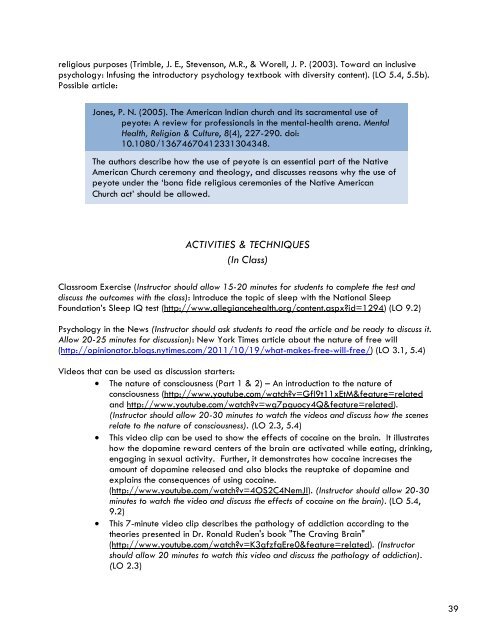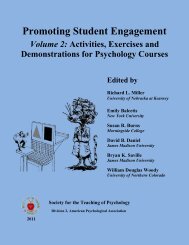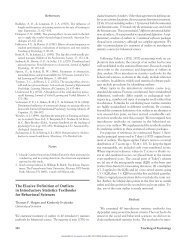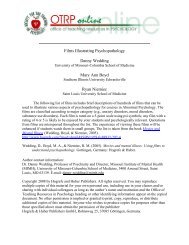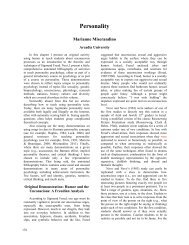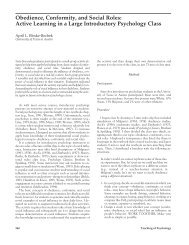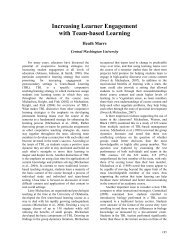INTRODUCTORY PSYCHOLOGY TEACHING PRIMER Early Career ...
INTRODUCTORY PSYCHOLOGY TEACHING PRIMER Early Career ...
INTRODUCTORY PSYCHOLOGY TEACHING PRIMER Early Career ...
You also want an ePaper? Increase the reach of your titles
YUMPU automatically turns print PDFs into web optimized ePapers that Google loves.
eligious purposes (Trimble, J. E., Stevenson, M.R., & Worell, J. P. (2003). Toward an inclusive<br />
psychology: Infusing the introductory psychology textbook with diversity content). (LO 5.4, 5.5b).<br />
Possible article:<br />
Jones, P. N. (2005). The American Indian church and its sacramental use of<br />
peyote: A review for professionals in the mental-health arena. Mental<br />
Health, Religion & Culture, 8(4), 227-290. doi:<br />
10.1080/13674670412331304348.<br />
The authors describe how the use of peyote is an essential part of the Native<br />
American Church ceremony and theology, and discusses reasons why the use of<br />
peyote under the ‘bona fide religious ceremonies of the Native American<br />
Church act’ should be allowed.<br />
ACTIVITIES & TECHNIQUES<br />
(In Class)<br />
Classroom Exercise (Instructor should allow 15-20 minutes for students to complete the test and<br />
discuss the outcomes with the class): Introduce the topic of sleep with the National Sleep<br />
Foundation’s Sleep IQ test (http://www.allegiancehealth.org/content.aspx?id=1294) (LO 9.2)<br />
Psychology in the News (Instructor should ask students to read the article and be ready to discuss it.<br />
Allow 20-25 minutes for discussion): New York Times article about the nature of free will<br />
(http://opinionator.blogs.nytimes.com/2011/10/19/what-makes-free-will-free/) (LO 3.1, 5.4)<br />
Videos that can be used as discussion starters:<br />
• The nature of consciousness (Part 1 & 2) – An introduction to the nature of<br />
consciousness (http://www.youtube.com/watch?v=GfI9t11xEtM&feature=related<br />
and http://www.youtube.com/watch?v=wg7pguocy4Q&feature=related).<br />
(Instructor should allow 20-30 minutes to watch the videos and discuss how the scenes<br />
relate to the nature of consciousness). (LO 2.3, 5.4)<br />
• This video clip can be used to show the effects of cocaine on the brain. It illustrates<br />
how the dopamine reward centers of the brain are activated while eating, drinking,<br />
engaging in sexual activity. Further, it demonstrates how cocaine increases the<br />
amount of dopamine released and also blocks the reuptake of dopamine and<br />
explains the consequences of using cocaine.<br />
(http://www.youtube.com/watch?v=4OS2C4NemJI). (Instructor should allow 20-30<br />
minutes to watch the video and discuss the effects of cocaine on the brain). (LO 5.4,<br />
9.2)<br />
• This 7-minute video clip describes the pathology of addiction according to the<br />
theories presented in Dr. Ronald Ruden's book "The Craving Brain"<br />
(http://www.youtube.com/watch?v=K3gfzfqEre0&feature=related). (Instructor<br />
should allow 20 minutes to watch this video and discuss the pathology of addiction).<br />
(LO 2.3)<br />
39


